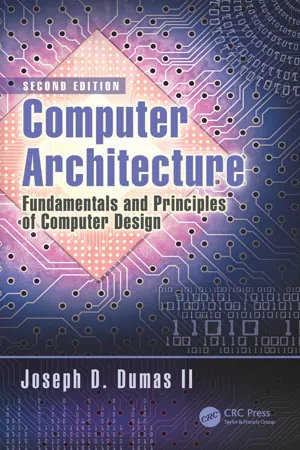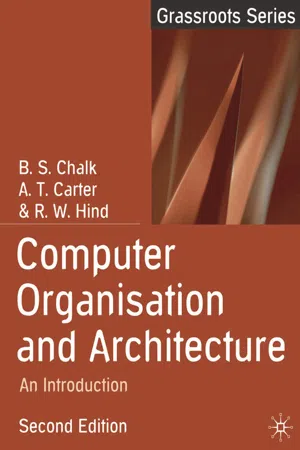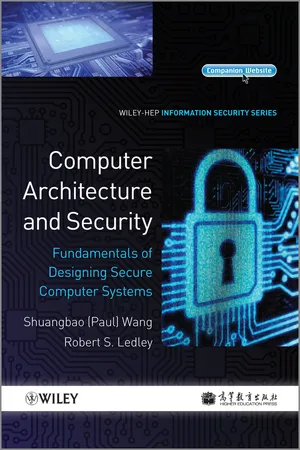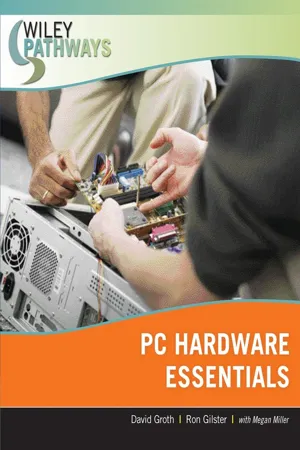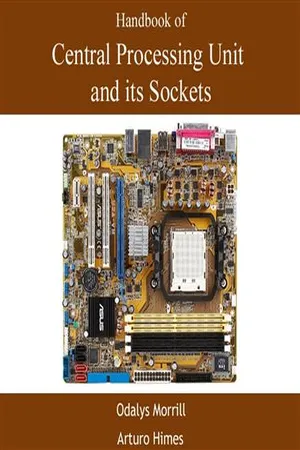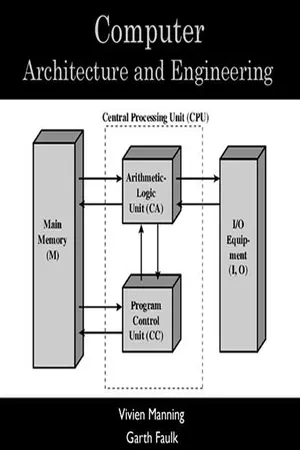Computer Science
Control Unit
The control unit is a component of a computer's central processing unit (CPU) that manages and coordinates the execution of instructions. It fetches instructions from memory, decodes them, and controls the flow of data within the CPU. The control unit plays a crucial role in ensuring that instructions are executed in the correct sequence and at the right time.
Written by Perlego with AI-assistance
Related key terms
1 of 5
12 Key excerpts on "Control Unit"
- eBook - PDF
- Greg Tomsho(Author)
- 2020(Publication Date)
- Cengage Learning EMEA(Publisher)
CPU Design We will discuss different design types of CPUs and various components of a CPU, but before we do, let’s take a look at its basic architecture. Most CPUs are composed of the following elements (see Figure 3-2): • Control Unit—The Control Unit (CU) is the director of operations in the CPU. The Control Unit provides timing and coordination between the other parts of the CPU, such as the arithmetic logic unit, registers, and system bus. For example, when a new instruction should be executed, the Control Unit receives and decodes the instruction and tells the arithmetic logic unit to execute it. • Arithmetic logic unit—The arithmetic logic unit (ALU) performs the primary task of any CPU, which is to execute instructions. These might be arithmetic instructions, such as addition or multiplication of integers, or logic instructions, such as binary AND or binary OR instructions. Most CPUs also contain a floating-point unit (FPU) that performs floating-point operations. • Registers—A register is a temporary holding location on a CPU where data must be placed before the CPU can use it. There are instruction registers that hold the instruction the CPU executes, such as add, multiply, or store. Also, the CPU uses address registers to access data stored in RAM and data registers that hold the data the CPU is currently working with, such as two numbers used in an add or multiply instruction. MODULE 3 The Central Processing Unit (CPU) 114 Copyright 2021 Cengage Learning. All Rights Reserved. May not be copied, scanned, or duplicated, in whole or in part. Due to electronic rights, some third party content may be suppressed from the eBook and/or eChapter(s). Editorial review has deemed that any suppressed content does not materially affect the overall learning experience. Cengage Learning reserves the right to remove additional content at any time if subsequent rights restrictions require it. - eBook - PDF
- Palmer, Greg Tomsho(Authors)
- 2016(Publication Date)
- Cengage Learning EMEA(Publisher)
Most CPUs are composed of the following elements (see Figure 3-1): 114 Chapter 3 The Central Processing Unit (CPU) Copyright 2017 Cengage Learning. All Rights Reserved. May not be copied, scanned, or duplicated, in whole or in part. WCN 02-300 CPU System bus: Control bus Address bus Data bus To RAM and I/O devices Control Unit (CU) Arithmetic logic unit (ALU) Registers Figure 3-1 Basic architecture of a CPU • Control Unit — t t The Control Unit (CU) is the director of operations in the CPU. The con-trol unit provides timing and coordination between the other parts of the CPU, such as the arithmetic logic unit, registers, and system bus. For example, when a new instruc-tion should be executed, the Control Unit receives and decodes the instruction and tells the arithmetic logic unit to execute it. • Arithmetic logic unit — The arithmetic logic unit (ALU) performs the primary task of any CPU, which is to execute instructions. These might be arithmetic instructions, such as addition or multiplication of integers, or logic instructions, such as binary AND or binary OR instructions. Most CPUs also contain a floating point unit (FPU) that per-forms floating point operations. • Registers — A register is a temporary holding location on a CPU where data must be placed before the CPU can use it. There are instruction registers that hold the instruction the CPU executes, such as add, multiply, or store. Also, the CPU uses address registers to access data stored in RAM, and data registers that hold the data the CPU is currently working with, such as two numbers used in an add or multiply instruction. • System bus — The system bus is a series of lanes that are used to communicate between the CPU and other major parts of the computer, such as RAM and input/output (I/O) devices. There are actually three types of buses: the control bus, address bus, and data bus. The control bus carries status signals between the CPU and other devices. - eBook - ePub
Computer Architecture
Fundamentals and Principles of Computer Design, Second Edition
- Joseph D. Dumas II(Author)
- 2016(Publication Date)
- CRC Press(Publisher)
chapter threeBasics of the central processing unit
The central processing unit (CPU) is the brain of any computer system based on the von Neumann (Princeton) or Harvard architectures introduced in Chapter 1 . Parallel machines have many such brains, but normally each of them is based on the same principles used to design the CPU in a uniprocessor (single CPU) system. A typical CPU has three major parts: the arithmetic/logic unit (ALU), which performs calculations; internal registers, which provide temporary storage for data to be used in calculations; and the Control Unit, which directs and sequences all operations of the ALU and registers as well as the rest of the machine. (A block diagram of a simple CPU is shown in Figure 3.1 .) The Control Unit that is responsible for carrying out the sequential execution of the stored program in memory is the hallmark of the von Neumann–type machine, using the registers and the arithmetic and logical circuits (together known as the datapath ) to do the work. The design of the Control Unit and datapath have a major impact on the performance of the processor and its suitability for various types of applications. CPU design is a critical component of overall system design. In this chapter, we look at important basic aspects of the design of a typical general-purpose processor; in the following chapter, we will go beyond the basics and look at modern techniques for improving CPU performance.3.1 The instruction set
One of the most important features of any machine’s architectural design, yet one of the least appreciated by many computing professionals, is its instruction set architecture (ISA). The ISA determines how all software must be structured at the machine level. The hardware only knows how to execute machine language instructions, but because almost all software is now developed in high-level languages rather than assembly or machine language, many people pay little or no attention to what type of instruction set a machine supports or how it compares to those used in other machines. As long as the system will compile and run a C++ program or support a Java virtual machine, is its native machine language really all that important? If all you are concerned with is getting a given program to run, probably not. But if you are interested in making a system perform to the best of its abilities, then it behooves you to know what those abilities really are, and the only ability of a CPU that really matters is its ability to execute machine instructions. What those instructions are, what they do, and how they support your high-level task can have a great deal to do with how quickly and efficiently that task will be done. Thus, it is worthwhile to study the similarities and differences between ISAs in order to be able to pick the best system for a given application. We examine important features of computer ISAs in this section. - eBook - PDF
Computer Architecture
Fundamentals and Principles of Computer Design, Second Edition
- Joseph D. Dumas II(Author)
- 2016(Publication Date)
- CRC Press(Publisher)
In particular, if magnetic RAM (see Section 2.1.2) proves to be fast, economical, and easy to integrate onto a chip with other types of logic (admittedly an ambitious list of goals for a new and unproven technology), then all bets are off. We could see a day in the not-too-distant future when processors have at least some writable, magnetic control store as standard equipment. 3.4 Chapter wrap-up Although all the subsystems of a modern computer are important, no part of the machine is as complex as its central processing unit (or units; paral-lel machines are discussed in Chapter 6). Under the direction of a highly specialized state machine known as the Control Unit, computational hard-ware must carry out arithmetic, logical, shifting, and other operations on Chapter three: Basics of the central processing unit 177 data stored in memory locations or registers as specifed by a machine language program written (or compiled) in accordance with the machine’s native instruction set. This instruction set may be very simple, extremely complex, or anywhere in between. In order to understand and keep up with technical developments in their feld, it is important for all computer professionals to have a good understanding of the major architectural and implementation consider-ations that go into the design of a modern CPU. Any student of computer science or computer engineering should learn about the wide variety of philosophies embodied in various ISAs; the techniques for designing fast, ef fcient datapath hardware to execute those instructions on integer and real number values; and the different approaches to designing the Control Unit that oversees all activities of the system. In Chapter 1, we discussed the differences between architectural design and implementation technology while noting that neither exists in a vacuum. Perhaps in no other part of a computer system do architec-ture and implementation infuence each other so much as they do inside the CPU. - eBook - PDF
Computer Organisation and Architecture
An Introduction
- B.S. Chalk, Antony Carter, Robert Hind(Authors)
- 2017(Publication Date)
- Red Globe Press(Publisher)
C H A P T E R 42 Central processor unit operation At the heart of a microcomputer system lies the Central Processor Unit (CPU) or processor . The processor runs a program by repeatedly fetching and executing instructions from main memory. By using a step-by-step approach, this chapter outlines the way in which this is done using a highly simplified processor. This will provide a foundation for understanding the operation of a real processor in Chapter 5. This chapter and Chapter 5 deal with the principles of machine code and assembly language programming . Machine code is the native code of the processor while assembly language is a more programmer friendly language that is translated into machine code by a program called an assembler . The full treatment of machine code and assembly language programming are found in other texts, some of which are listed in the references at the end of the book. The purpose of this chapter and the next is to explain and demonstrate how the components of a processor work together to carry out tasks. 4.1 CPU details In Chapter 1 we identified the role of the data, address and control buses for transferring data between the processor and other system components, selecting a memory or I/O device and for synchronising the operation of system components respectively. In Figure 4.1 we see how the system buses relate to internal processor elements. In this simplified CPU architecture only memory read and write control signals are shown. IP is the Instruction Pointer . This is the name used by Intel in their processors, although Program Counter is a name commonly used for this register. A register is a memory location within the processor. A is the name we have given to a general purpose register within the processor. Such registers are sometimes referred to as accumulators . The Memory Address Register (MAR) holds data going on to the address bus. The Memory Buffer Register (MBR) holds data going to/from the data bus. - eBook - PDF
- Mark Burrell(Author)
- 2017(Publication Date)
- Red Globe Press(Publisher)
17.2 Inside The Control Unit Now we have a direct link between the execution of our program and the enabling and clocking of individual registers at the hardware level. However, we still need to define how the CU itself works, and we will move on to that now by introducing the internal structure of the CU, as shown in figure 17.3. As you can see, inside the CU we have a device that looks very much like our processor, but in miniature. In fact this device works in a similar fashion to the overall processor, the difference being that this level is aimed entirely at running individual instructions. Each instruction has been allocated a mi-croprogram , which is the sequence of micro-instructions that execute that instruction. The Control Unit has a micromemory for storing all the micro-instructions that make up individual instructions (as we saw for just one instruction in figure 17.2), it has a microMAR and a microMDR to access this memory, and it has a microPC to step through the micro-instructions that make up a particular 286 The Control Unit instruction. The microCU is the engine of the CU. This is a complex circuit that is built from gate logic as we saw back in chapter 3. There is not another tiny Control Unit inside the microCU -we are now at the lowest level of our processor. We won’t take a look inside the microCU (it will be implemented as gate logic), instead we will focus on what it does. Address Mapper MicroPC MicroINC MicroMDR MicroMAR MicroCU MicroMemory IR Control Signals Interrupt Request PSR Flags Clock Opcode Figure 17.3 Inside the Control Unit We will now work through what the CU does to process an instruction. - eBook - ePub
Computer Architecture and Security
Fundamentals of Designing Secure Computer Systems
- Shuangbao Paul Wang, Robert S. Ledley(Authors)
- 2012(Publication Date)
- Wiley(Publisher)
Chapter 6 Central Processing UnitCentral Processing Unit (CPU) is the brain of a computer system. A computer can be classified as a super computer, a mainframe computer, a minicomputer, a microcomputer, or a handheld computer. Each of the above mentioned computers may contain one or more processors. Usually enterprise computers (servers) contain more processors than personal computers. A CPU has a certain number of address, data, and control bus signals. The number of data bits that can be processed at one time is called a word. Unlike byte which is a fixed number equaled to 8 bits. The word size differs from computers to computers. For example, the word for a 32-bit computer is 32/8 = 4 bytes, while the word for a 64-bit computer is 64/8 = 8 bytes.6.1 The Instruction Set
The instruction set provides an interface that allows users to make full use of the processor. The selection of the instructions is determined by the application for which the processor is intended. For example, a computational intensive computer may choose processors that are built with larger word size, more math functions and lots of memory management features. On the other hand, a processor designed for embedded systems such as TV remote controls and air conditioners may only contain less or simple instructions, small word size and easy addressing features.6.1.1 Instruction Classifications
Instructions usually contain two components: operation code (opcode ) and operands . An instruction can have one opcode and zero or more operands. Some common instruction formats are shown in Figure 6.1 - David Groth, Ron Gilster, Megan Miller(Authors)
- 2015(Publication Date)
- Wiley(Publisher)
There are software utili- ties that you can download or purchase that you can use to monitor tem- peratures while the PC is running. You can also purchase circuit boards that monitor internal temperature and will shut the computer off if it reaches high temperatures. For critical network servers, heat sensors can potentially save a lot of money in repair costs. 4.2 CPU Features and Technologies Technically speaking, a CPU is an integrated circuit that contains millions of tran- sistors interconnected by small aluminum wires. The CPU’s processing capabilities control and direct the activities of the PC by interacting with the other electronic components on the motherboard, such as the main memory, bus structures, cache memory, and device interfaces. Although CPUs today share some of the same basic technical operations with the earliest CPUs, CPU technologies have vastly improved over the last decade. When comparing and selecting CPUs, you need to understand some of the modern technologies used with today’s processors. 4.2.1 CPU Basic Operations The role of the CPU is to control and direct all the activities of the computer using both external and internal buses. The CPU is a processor chip consisting of an array of millions of transistors, semi-conductor devices that at their most basic level act as switches for electronic signals. Essentially, through vast combi- nations of switches turning on and off, and sending intricate routines of 1s and 0s, the CPU is able to perform complex calculations and operations on data. The CPU’s function is to take and process instructions. An example of a simple instruction is adding two numbers in a calculator program. Instructions, whether originating from software or an input/output device, are loaded into RAM and then sent over the system bus to the CPU. Components of a CPU include: ▲ The Control Unit: The CPU circuitry that coordinates the rest of the CPU’s actions and interactions 1.- No longer available |Learn more
- (Author)
- 2014(Publication Date)
- Learning Press(Publisher)
________________________ WORLD TECHNOLOGIES ________________________ Chapter 1 Central Processing Unit Die of an Intel 80486DX2 microprocessor (actual size: 12×6.75 mm) in its packaging. The central processing unit ( CPU ) is the portion of a computer system that carries out the instructions of a computer program, and is the primary element carrying out the computer's functions. The central processing unit carries out each instruction of the program in sequence, to perform the basic arithmetical, logical, and input/output operations of the system. This term has been in use in the computer industry at least since the early 1960s. The form, design and implementation of CPUs have changed dramatically since the earliest examples, but their fundamental operation remains much the same. ________________________ WORLD TECHNOLOGIES ________________________ Early CPUs were custom-designed as a part of a larger, sometimes one-of-a-kind, com-puter. However, this costly method of designing custom CPUs for a particular application has largely given way to the development of mass-produced processors that are made for one or many purposes. This standardization trend generally began in the era of discrete transistor mainframes and minicomputers and has rapidly accelerated with the popu-larization of the integrated circuit (IC). The IC has allowed increasingly complex CPUs to be designed and manufactured to tolerances on the order of nanometers. Both the miniaturization and standardization of CPUs have increased the presence of these digital devices in modern life far beyond the limited application of dedicated computing mac-hines. Modern microprocessors appear in everything from automobiles to cell phones and children's toys. History EDVAC, one of the first electronic stored program computers. - No longer available |Learn more
- (Author)
- 2014(Publication Date)
- College Publishing House(Publisher)
________________________ WORLD TECHNOLOGIES ________________________ Chapter 1 Central Processing Unit Die of an Intel 80486DX2 microprocessor (actual size: 12×6.75 mm) in its packaging The central processing unit ( CPU ) is the portion of a computer system that carries out the instructions of a computer program, and is the primary element carrying out the computer's functions. The central processing unit carries out each instruction of the program in sequence, to perform the basic arithmetical, logical, and input/output operations of the system. This term has been in use in the computer industry at least since the early 1960s. The form, design and implementation of CPUs have changed dramatically since the earliest examples, but their fundamental operation remains much the same. ________________________ WORLD TECHNOLOGIES ________________________ Early CPUs were custom-designed as a part of a larger, sometimes one-of-a-kind, computer. However, this costly method of designing custom CPUs for a particular application has largely given way to the development of mass-produced processors that are made for one or many purposes. This standardization trend generally began in the era of discrete transistor mainframes and minicomputers and has rapidly accelerated with the popularization of the integrated circuit (IC). The IC has allowed increasingly complex CPUs to be designed and manufactured to tolerances on the order of nanometers. Both the miniaturization and standardization of CPUs have increased the presence of these digital devices in modern life far beyond the limited application of dedicated computing machines. Modern microprocessors appear in everything from automobiles to cell phones and children's toys. History EDVAC, one of the first electronic stored program computers - No longer available |Learn more
- (Author)
- 2014(Publication Date)
- College Publishing House(Publisher)
________________________ WORLD TECHNOLOGIES ________________________ Chapter 3 Central Processing Unit Die of an Intel 80486DX2 microprocessor (actual size: 12×6.75 mm) in its packaging. The central processing unit ( CPU ) is the portion of a computer system that carries out the instructions of a computer program, and is the primary element carrying out the computer's functions. The central processing unit carries out each instruction of the program in sequence, to perform the basic arithmetical, logical, and input/output operations of the system. This term has been in use in the computer industry at least since the early 1960s. The form, design and implementation of CPUs have changed dramatically since the earliest examples, but their fundamental operation remains much the same. ________________________ WORLD TECHNOLOGIES ________________________ Early CPUs were custom-designed as a part of a larger, sometimes one-of-a-kind, computer. However, this costly method of designing custom CPUs for a particular application has largely given way to the development of mass-produced processors that are made for one or many purposes. This standardization trend generally began in the era of discrete transistor mainframes and minicomputers and has rapidly accelerated with the popularization of the integrated circuit (IC). The IC has allowed increasingly complex CPUs to be designed and manufactured to tolerances on the order of nanometers. Both the miniaturization and standardization of CPUs have increased the presence of these digital devices in modern life far beyond the limited application of dedicated computing machines. Modern microprocessors appear in everything from automobiles to cell phones and children's toys. History EDVAC, one of the first electronic stored program computers - No longer available |Learn more
- (Author)
- 2014(Publication Date)
- Learning Press(Publisher)
________________________ WORLD TECHNOLOGIES ________________________ Chapter 3 Central Processing Unit Die of an Intel 80486DX2 microprocessor (actual size: 12×6.75 mm) in its packaging. The central processing unit ( CPU ) is the portion of a computer system that carries out the instructions of a computer program, and is the primary element carrying out the computer's functions. The central processing unit carries out each instruction of the program in sequence, to perform the basic arithmetical, logical, and input/output operations of the system. This term has been in use in the computer industry at least since ________________________ WORLD TECHNOLOGIES ________________________ the early 1960s. The form, design and implementation of CPUs have changed drama-tically since the earliest examples, but their fundamental operation remains much the same. Early CPUs were custom-designed as a part of a larger, sometimes one-of-a-kind, com-puter. However, this costly method of designing custom CPUs for a particular application has largely given way to the development of mass-produced processors that are made for one or many purposes. This standardization trend generally began in the era of discrete transistor mainframes and minicomputers and has rapidly accelerated with the popularization of the integrated circuit (IC). The IC has allowed increasingly complex CPUs to be designed and manufactured to tolerances on the order of nanometers. Both the miniaturization and standardization of CPUs have increased the presence of these digital devices in modern life far beyond the limited application of dedicated computing machines. Modern microprocessors appear in everything from automobiles to cell phones and children's toys. ________________________ WORLD TECHNOLOGIES ________________________ History EDVAC, one of the first electronic stored program computers.
Index pages curate the most relevant extracts from our library of academic textbooks. They’ve been created using an in-house natural language model (NLM), each adding context and meaning to key research topics.



